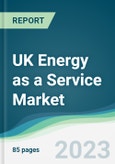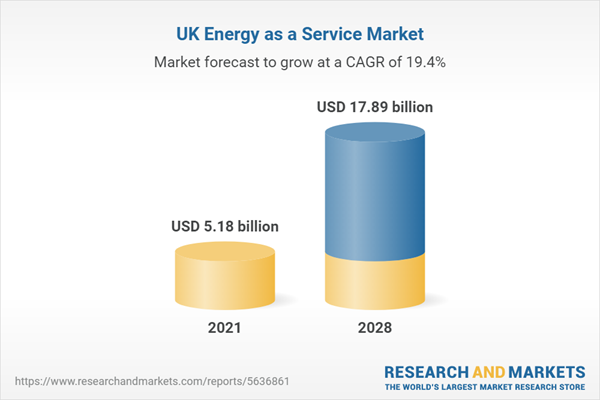The UK energy as a service market is expected to expand at a CAGR of 19.36% to reach a market size of US$17.891 billion in 2028 from an initial value of US$5.184 billion in 2021.
Energy as a service involves generating energy using renewable sources such as wind, solar, or hydro and then providing the same to passive consumers. The growing initiatives by the UK to achieve zero carbon emission, favorable investments, growing digitization, and adoption of smart meters are driving the demand for energy as a service in the country. In March 2023, the Department for Energy Security and Net Zero unveiled its plans to scale the production of clean, homegrown energy, which included investments of £160 million in the UK's floating offshore wind industry and £240 million to back the country's new green hydrogen production projects. Moreover, per the same source, the government also opened the fifth round of its "Contracts-for-Difference" scheme to incentivize investments in renewable electricity.The growing shift towards renewable energy adoption is positively impacting the market growth.
The carbon emission created while burning fossil fuels for electricity generation causes pollution problems and climatic change. To reduce its carbon footprint, the UK focuses on increasing the usage of renewable energy sources such as wind, solar, and nuclear for electricity generation. For instance, according to the Office of National Statistics data, in March 2023, UK's installed solar capacity stood at 14.9 GW, which represented an increase of 5.3% compared to 2022's installation volume for the same month. The UK government is also investing in solar projects; for instance, in July 2022, the UK government announced £3 million for space-based solar projects, which would act as a reliable alternative to volatile fossil fuels.Besides solar capacity, the UK is also emphasizing its wind energy generation. According to the Office of National Statistics, in December 2022, UK's electricity generation through wind energy was recorded at a high share of 24.6% of the total generation, which showed a significant increase compared to 2020. The country's Hornsea 2 offshore wind farm became operational on December 2021 and is considered the biggest offshore wind farm globally. Furthermore, favorable investment in power grids and project establishments is acting as an additional driving factor, as reliable grid management will increase the efficiency of energy distribution.
The commercial segment of the UK energy as a service market has experienced notable growth opportunities.
Energy as a service provider has capitalized on the increasing demand for renewable energy procurement, management, and optimization services, helping businesses achieve their sustainability targets while optimizing energy usage and reducing costs. The surge in electricity production from renewable sources has positioned the commercial segment as a key driver of the energy transition towards a low-carbon future in the UK.Market Developments:
- In March 2023, Dogger Bank Wind Farm formally acknowledged the opening of its Operations and Maintenance Base. The Dogger Bank Wind Farm's operational center will be at the O&M base in Port of Tyne. The control room that will oversee and manage 5% of the UK's power-producing capacity, which the offshore wind farm generates, is also located at the O&M facility.
- In November 2022, the Office of Gas and Electricity Market announced that the UK government had approved the funding of £22.2 billion for six electricity distribution network companies to improve their fourteen local networks in the UK. The grid investment was part of the UK strategy to increase its renewable electricity capacity by 2028.
Market Segmentation:
Service Type
- Supply Services
- Operation & Maintenance
- Energy Optimization and Efficiency
By End-User
- Industrial
- Commercial
By States
- England
- Scotland
- Wales
- Northern Ireland
Table of Contents
Companies Mentioned
- EDF Energy
- Engie
- E.ON
- Npower
- Scottish Power Ltd.
- Vattenfall
- Vital Enrgi
- SSE PLC
- Anesco Ltd
Methodology

LOADING...
Table Information
| Report Attribute | Details |
|---|---|
| No. of Pages | 85 |
| Published | June 2023 |
| Forecast Period | 2021 - 2028 |
| Estimated Market Value ( USD | $ 5.18 billion |
| Forecasted Market Value ( USD | $ 17.89 billion |
| Compound Annual Growth Rate | 19.3% |
| Regions Covered | United Kingdom |
| No. of Companies Mentioned | 9 |









